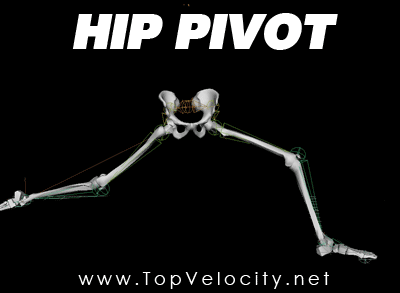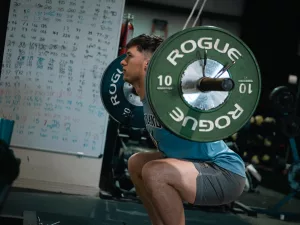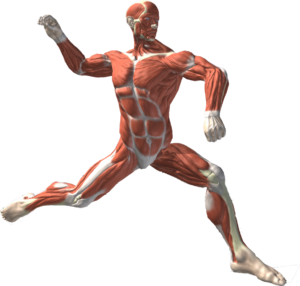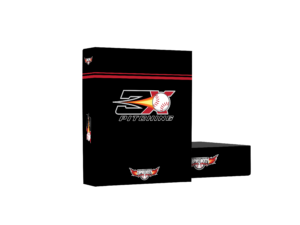Baseball pitchers frequently experience knee pain, which can have a negative impact on their performance and even cause them to miss games or entire seasons. Pitchers may experience knee pain for a variety of reasons, but one of the most common ones is a lack of lower-half muscular strength and improper mechanics related to late hip rotation when pitching. The processes underlying this problem will be examined in this article, including how poor hip rotation timing can put too much strain on the knee joint and its supporting structures, causing discomfort and possibly more serious injuries. We will also go over the significance of strengthening the lower body and using correct pitching mechanics to avoid knee pain and improve performance on the mound.
The Role of Hip Rotation in Knee Pain for Pitchers
 A key component of the pitching action is hip rotation, which enables pitchers to produce power and velocity while also controlling the pitch's direction. However, too much stress can be placed on the knee joint if the hip rotation occurs too late in the pitching action, resulting in pain and discomfort. Pitchers who land in an unsteady posture due to late hip rotation are more likely to sustain knee injuries.
A key component of the pitching action is hip rotation, which enables pitchers to produce power and velocity while also controlling the pitch's direction. However, too much stress can be placed on the knee joint if the hip rotation occurs too late in the pitching action, resulting in pain and discomfort. Pitchers who land in an unsteady posture due to late hip rotation are more likely to sustain knee injuries.
Due to the knee joint rotating inward and applying weight to the medial aspect of the knee, late hip rotation is one factor that can lead to knee pain. The medial collateral ligament (MCL), a vital knee stabilizing component, may become irritated and inflamed as a result. In extreme circumstances, late hip rotation can rupture the MCL, necessitating months of recovery and possibly terminating a pitcher's season.
Pitchers who fall with their knees extended rather than flexed, as a result of early hip rotation, put more stress on the patellar tendon. Patellar tendinitis, a painful condition that can be challenging to treat and may call for rest and physical treatment, can result from this.
Finally, hip rotation timing plays a major role in pitchers' knee pain. Pitchers and coaches can address this problem by using proper mechanics and developing lower body strength by comprehending the mechanics underlying it. They can minimize their chance of knee injuries and improve their performance on the mound by doing this.
Building Lower Body Strength to Prevent Knee Pain
 In order to avoid knee pain and injury, pitchers must develop their lower body strength. Pitchers can transfer energy from their lower body to their upper body and produce more power and velocity while putting less strain on their joints when they have strong legs, which serve as a stable foundation for the pitching action.
In order to avoid knee pain and injury, pitchers must develop their lower body strength. Pitchers can transfer energy from their lower body to their upper body and produce more power and velocity while putting less strain on their joints when they have strong legs, which serve as a stable foundation for the pitching action.
Pitchers should concentrate on exercises that target the glutes, quads, and hamstrings, such as squats, lunges, deadlifts, and cleans, to increase lower body power. These workouts should be performed with good form and a weight that tests the pitcher's technique without impairing it.
Additionally, plyometric exercises like box jumps and lateral jumps can help pitchers improve their landing mechanics and create explosive power. Additionally, by enhancing neuromuscular control, these exercises can lower the chance of knee injuries.
Pitchers can improve their landing stability and lower their risk of knee injuries by incorporating balance and stability movements like single-leg squats and lunges. The proprioceptive system, which is necessary for preserving correct body alignment and control during dynamic movements like pitching, is put to the test by these activities. The 3X Pitching Velocity Program has all of the training plans needed to develop the lower half strength and more.
Proper Pitching Mechanics to Avoid Knee Injuries and Optimize Performance
 Knee injuries can be prevented and efficiency can be improved with proper pitching mechanics. Pitchers can lessen the strain on their joints, transfer energy effectively, and maintain proper body alignment throughout the pitching action when they use proper mechanics.
Knee injuries can be prevented and efficiency can be improved with proper pitching mechanics. Pitchers can lessen the strain on their joints, transfer energy effectively, and maintain proper body alignment throughout the pitching action when they use proper mechanics.
Keeping a solid and stable landing posture is a crucial aspect of correct pitching mechanics. In order to land properly, pitchers should try to do so with their front foot pointed toward home plate 20 degrees closed, their knee flexed, and an even distribution of weight on their front and rear legs. In addition to improving the pitcher's ability to control the direction of their pitches, this secure landing posture can lower the risk of knee injuries.
Maintaining excellent alignment and posture throughout the pitching motion is another essential component of correct pitching mechanics. Leaning too far forward or backward can place undue strain on the knees and other joints, so pitchers should try to avoid doing it. Additionally, they should avoid excessive spine rotation or tilting and maintain a close to neutral posture for their head and shoulders.
Finally, rather than relying exclusively on their arm, pitchers should concentrate on building power from their lower body. This calls for using the correct pitching motion sequencing, which starts with a powerful load moving forward and down from the rubber with the hips, which is followed by hip to shoulder separation and is finished off with a dynamic forward trunk finish. Pitchers can improve their velocity and lessen stress on their arms while lowering their risk of knee injuries by generating force with their lower body.
3X Pitching to Prevent Knee Pain When Pitching
 The 3X Pitching Velocity Program is a great spot to start if you're a pitcher looking to increase your effectiveness while also lowering your risk of knee injuries. This program is specially made to assist pitchers in creating sound mechanics and increasing the lower body power required to pitch at their best.
The 3X Pitching Velocity Program is a great spot to start if you're a pitcher looking to increase your effectiveness while also lowering your risk of knee injuries. This program is specially made to assist pitchers in creating sound mechanics and increasing the lower body power required to pitch at their best.
You can access a thorough training system with the 3X Pitching Velocity Program, which includes education on proper pitching mechanics, strength and conditioning plans to develop healthy elite athletes, and it comes with a video analysis to help identify what is causing your problems. You'll learn the correct pitching mechanics, including how to use your lower body to generate power and transfer this to the baseball.
Tthe 3X Pitching Velocity Program is a great option if you want to maximize your efficiency as a pitcher while lowering your risk of knee injuries. Join now to begin building the strong lower body movements and pitching technique you need.




